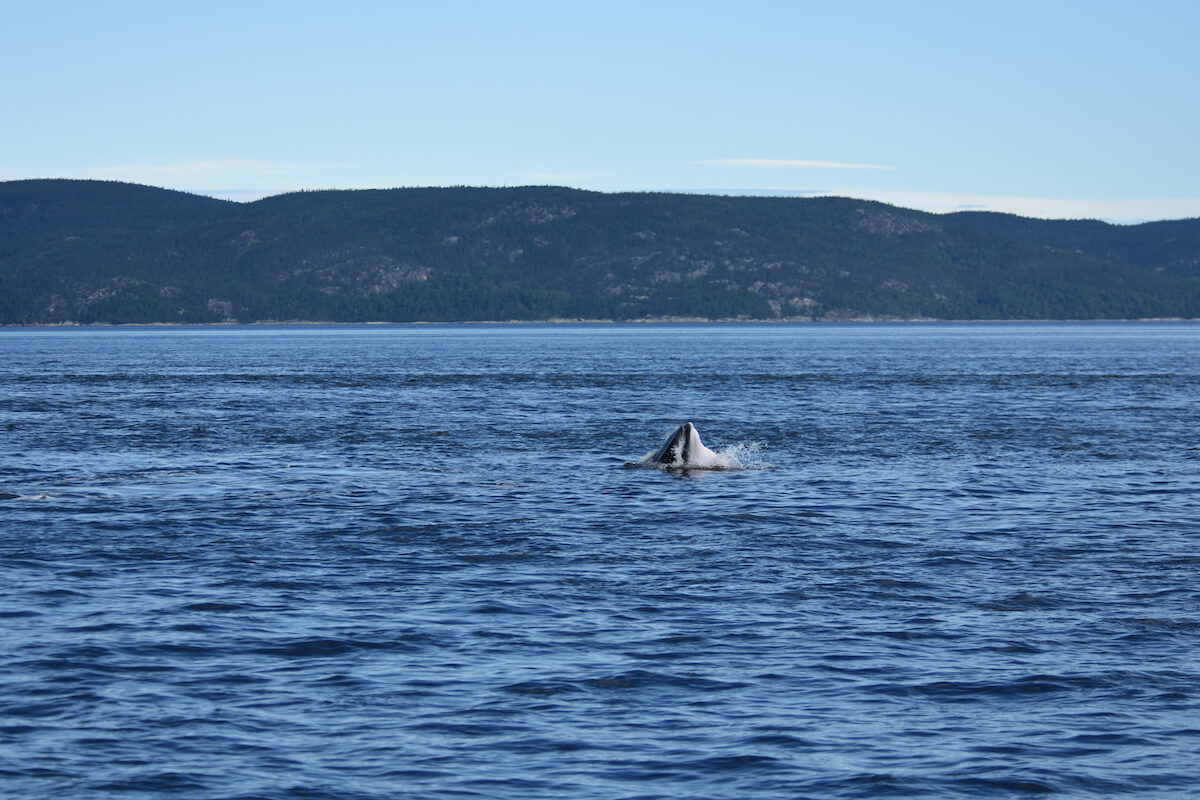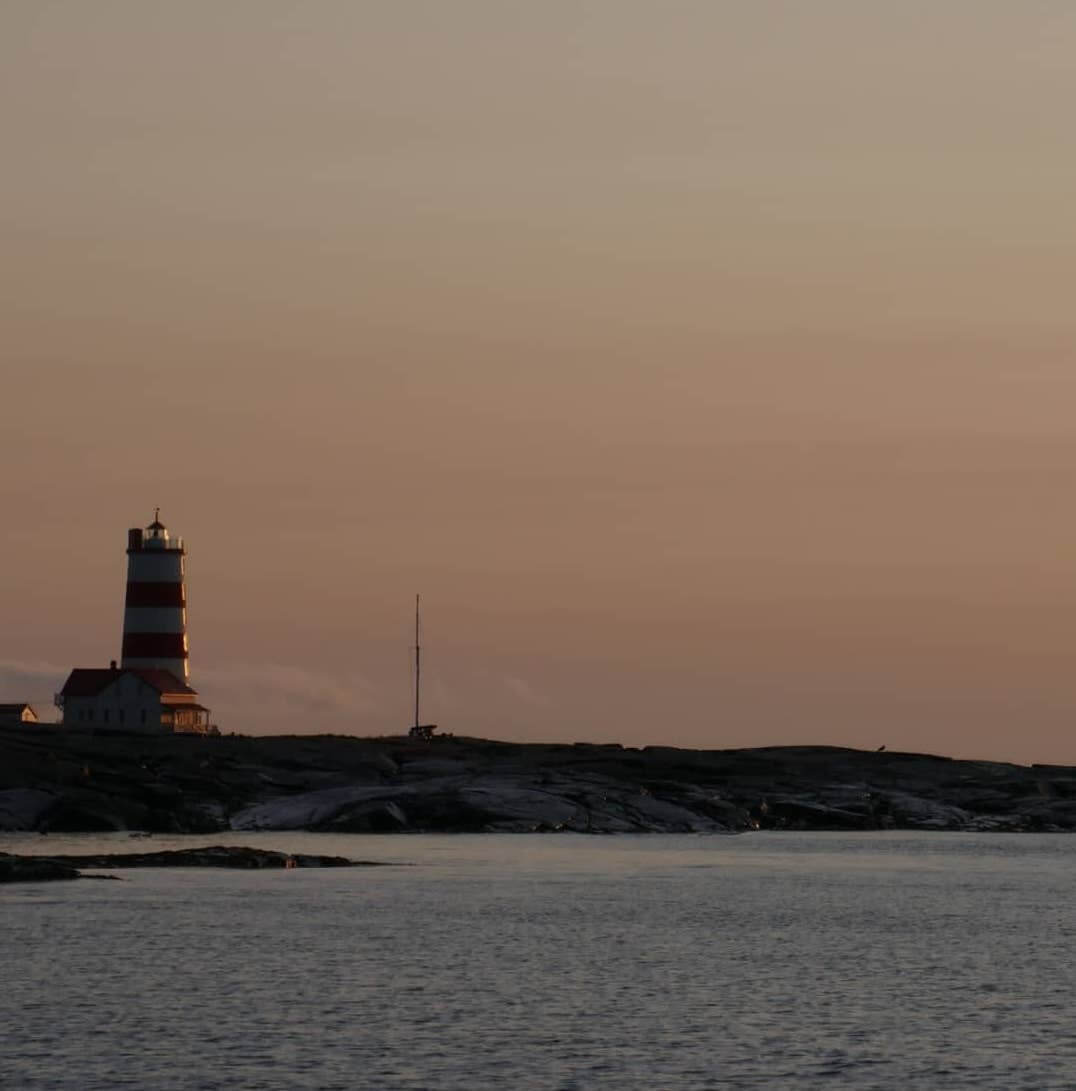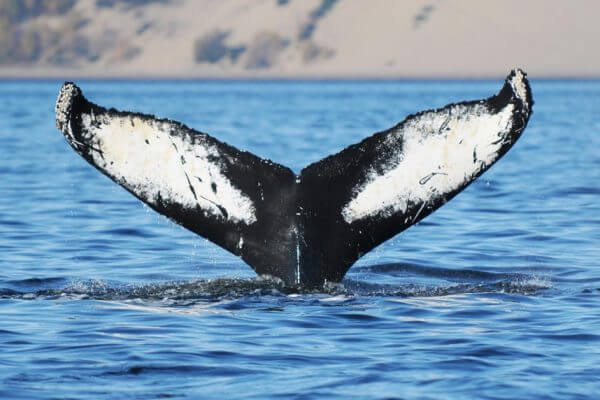There are enormous benefits to working and living in whale country. Now my home base, Tadoussac is a tourist destination for many, a place of discovery for some or simply a family retreat for others, but above all, a place where magic can happen at any time.
This is what I realized on Tuesday, July 5. At around 5:30 p.m., one of the naturalists comes out to the entryway of the Marine Mammal Interpretation Centre (CIMM), where the editorial offices are also located, and alerts us: “Minke whales on the horizon!” This marks the end of my work day. Everyone heads outside. Two or three minke whales are close to shore and one of them is performing acrobatic feeding manoeuvres. Despite the thirty or so people present on the rocks, it is quiet as the crowd stands in awe. An avid photographer hurries to get her camera. Naturalists explain the species’ behaviour to the visitors. A native of the region contemplates the landscape and shares her gratification with me. Belugas swimming near Pointe de l’Islet complete the portrait while a few cormorants raise a ruckus on the water’s edge.
A little later that evening, on my way back from the grocery store, I stop on the boardwalk overlooking the beach to observe a minke whale in the bay. Next to me, I overhear an exchange amongst a family of tourists:
- “Wow! Did you see that whale?” the young boy asks his parents, who had their backs to the bay.
- “No. I don’t see anything on the water… I think what you saw was those three little ducks swimming over there in the water. You see, over there,” chuckle the parents and little sister, pointing to the birds.
- “No, I swear I saw a whale! It wasn’t ducks!” replies the little boy, upset that no one believed him.
Just then, the minke whale shows the tip of its nose and performs a magnificent feeding manoeuvre, even showing off its all-white belly. That put an end to the teasing in no time!
“This is where the action is”
Whale country is vast, so the magic of opportunistic sightings can be felt all along the St. Lawrence. Where were whales observed this past week?
Minke whales were present almost everywhere and were regularly observed from Franquelin to the Saguenay-St. Lawrence Marine Park, while a dozen or so of these small baleen whales were also seen in Gaspé Bay every day. A cetacean enthusiast also reports a sighting off Colombier, while farther upstream, in Saint-Siméon, an individual surprised visitors and residents when it approached the municipal marina on July 4.
We would be remiss not to mention humpbacks, with their continual presence in Pointe-Saint-Pierre, Grande-Grave and Gaspé. While a few individuals also turn heads off Les Escoumins and Les Bergeronnes, it is farther downstream, where the estuary meets the gulf, that they are particularly plentiful. “Yesterday I was visiting the magnificent lighthouse in Pointe-des-Monts, says one whale lover. When I got to the top of the lighthouse, there were several spouts and probably about three humpbacks. It was quite gusty, so I didn’t dare take out my phone. I was afraid the wind would blow it out of my hand, but they were so close I could have filmed them. There is even one that breached. Amongst the humpbacks there were several minke whales swimming around, so I imagine there was a good supply of food there. Suffice to say, Pointe-des-Monts was the place to be this week!”
As for belugas, a number were observed on the south shore in Saint-Fabien-Sur-Mer at Anse à Capelans, while three of these white whales were also seen off Grosses-Roches. They have also been regularly plying the waters of the Saguenay Fjord between Pointe-Noire in Baie-Sainte-Catherine and Baie Sainte-Marguerite in Sacré-Coeur, even venturing close to the docks in L’Anse-de-Roche. Lastly, a herd of 40 belugas was observed off Les Bergeronnes on June 30.
Harbour porpoises are observed in Gaspé Bay. A naturalist paddling a sea kayak also observed around 50 porpoises off the coast of Les Bergeronnes.
Lastly, in terms of pinnipeds, a few heads of harbour seals and grey seals were also noted here and there.
Whales without borders
It can be amazing how quickly marine mammals move around and how vast their territories are. The humpback whale H626, a.k.a. Gaspar or BBR, which was observed in the Gaspé last week, travelled to the Marine Park this week, where she was photographed off Les Escoumins. Known since 2008, this female is regularly seen in the waters of the Gaspé Peninsula at the start of the season, but most often moves to the waters of the estuary by mid-summer. While some humpbacks have their favourite feeding grounds in the St. Lawrence, others, like Gaspar, frequent several sectors of the riverin the same season.
In any case, the arrival of this local ‘star’ caused quite a commotion in the community. That’s how village life is in whale country: rumours and gossip revolve not around movie celebrities, but rather the sighting of the first blue whale offshore or the interpretation of the latest cetacean photos.
Where are the Whales this week? Map of the observations
Here is the map of observations reported this week. It gives an idea of the presence of whales and does not at all represent the actual distribution of whales in the St. Lawrence. Use it for fun!
A tightly knit network of experienced observers who live according to the rhythm of the St. Lawrence throughout the year. On the waves or on shore, they scan the horizon with passion and patience, watching for the slightest spout. It is thanks to their sharp eyes and living words that we are able to write News from Afield week in and week out. A big thank you to all of our precious collaborators!
Click on the whale or the seal icon to find out more about the corresponding observation (species, number of individuals, info, pictures). To enlarge the map, click on the top right corner icon.
The map is published from the first week of June to the end of September.









